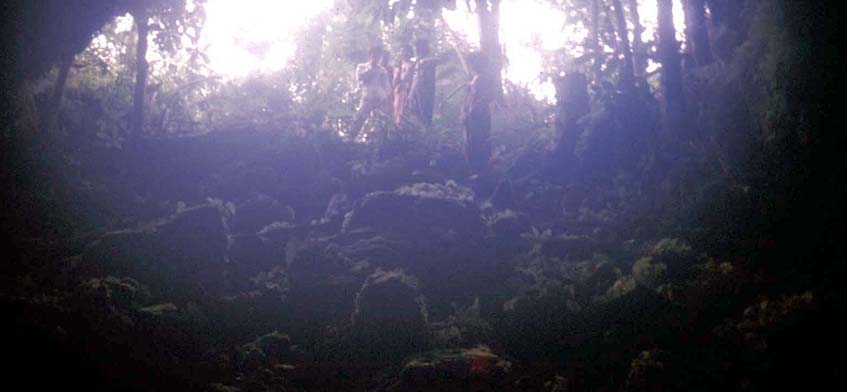
Upolu, Western Samoa
by gene carl feldman

![]() To give a little background, after more than three years in Samoa it was getting close to the time when my work would be coming to an end. For much of the last year, I had been living just outside of Apia, working mostly at the Fisheries Division on the FAO-sponsored Village Fisheries Development Project. During the earlier part of my stay, I had been working on a number of projects starting with a sea turtle conservation project down in Aleipata and then moving out to Savai'i to design and build an outboard engine repair workshop and then finally into the swamps of Vaitola with a bunch of shovels and a couple of my coworkers to dig six fishponds by hand for a baitfish culture project. It was time for something new. Part of this new development project involved working with a wonderful group of local Samoan carpenters, led by master wood carver Sven Ortquist (pictured at left keeping a close eye on me) building boats. Working with the FAO marine architect who designed the boats, these guys would turn out both an 18 and 28 foot version of an outboard-propelled fishing boat that would be purchased by fisherman from villages all around Samoa.
To give a little background, after more than three years in Samoa it was getting close to the time when my work would be coming to an end. For much of the last year, I had been living just outside of Apia, working mostly at the Fisheries Division on the FAO-sponsored Village Fisheries Development Project. During the earlier part of my stay, I had been working on a number of projects starting with a sea turtle conservation project down in Aleipata and then moving out to Savai'i to design and build an outboard engine repair workshop and then finally into the swamps of Vaitola with a bunch of shovels and a couple of my coworkers to dig six fishponds by hand for a baitfish culture project. It was time for something new. Part of this new development project involved working with a wonderful group of local Samoan carpenters, led by master wood carver Sven Ortquist (pictured at left keeping a close eye on me) building boats. Working with the FAO marine architect who designed the boats, these guys would turn out both an 18 and 28 foot version of an outboard-propelled fishing boat that would be purchased by fisherman from villages all around Samoa.
![]() Another part of my job involved taking one of the boats and going from village to village with a few of the best fishermen from the Fisheries Division and spending a few days in each village demonstrating the boats and the different fishing techniques that they offered. Rather than just trolling for tuna or fishing in the relatively shallow, protected waters within the reef, these boats could be taken offshore and with large reels of heavy monofilament line mounted on each side, it was now possible to fish the very productive and relatively untapped deep ocean depths, generally one hundred fathoms or more. Of course, this meant fishing throughout the night, bobbing around in a relatively small boat with perhaps three other fishermen and by the end of the night, adding to the mix several hundred pounds of fish in every size and shape and smell.
The project was so successfull and the fish catches so plentiful that I soon started taking twice weekly trips around the island of Upolu, hanging on for dear life to the back of a giant flatbed truck that held four large boxes containing ice on the outbound trip and hundreds of pounds of fish that were caught in the remote villages on the return. But as they say, that's a story for another time.
Another part of my job involved taking one of the boats and going from village to village with a few of the best fishermen from the Fisheries Division and spending a few days in each village demonstrating the boats and the different fishing techniques that they offered. Rather than just trolling for tuna or fishing in the relatively shallow, protected waters within the reef, these boats could be taken offshore and with large reels of heavy monofilament line mounted on each side, it was now possible to fish the very productive and relatively untapped deep ocean depths, generally one hundred fathoms or more. Of course, this meant fishing throughout the night, bobbing around in a relatively small boat with perhaps three other fishermen and by the end of the night, adding to the mix several hundred pounds of fish in every size and shape and smell.
The project was so successfull and the fish catches so plentiful that I soon started taking twice weekly trips around the island of Upolu, hanging on for dear life to the back of a giant flatbed truck that held four large boxes containing ice on the outbound trip and hundreds of pounds of fish that were caught in the remote villages on the return. But as they say, that's a story for another time.
I can't remember exactly how I learned about the cave at Falemauga, but I'd heard rumors that there was an old lava tube not too far outside of Apia that had some connection to ancient Samoan history. After much searching and many false leads, I finally found someone who said they knew exactly where the cave was and that if I were interested, they'd be willing to take me there. Not having any idea what to expect, I was somewhat less than properly outfitted when the two of us set off on my little motorcycle. The journey involved many false turns, a few near collisions with renegade pigs and chickens, more than one encounter with some very angry Samoan dogs until we finally reached the end of the road - literally.
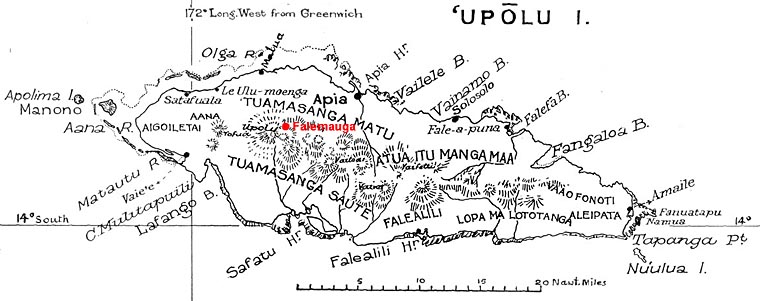
Thankfully, after just a few wrong turns, my companion managed to lead the way through the rather dense brush and after not too long a walk, we found ourselves gazing down into a rather large, vegetation-covered hole in the ground. On one side of the "crater", which was approximately 50 feet or so in diameter, was a very large opening that was easy to enter and had enough natural light so that it was quite easy to make my way over and around all the boulders that filled the entrance. However, not too far in, the entrance narrowed and I was left facing a rather small opening that led into the stygian darkness. Turning around, I walked back out of the opening and around the perimeter of the crater until I came upon another and much smaller entrance on the opposite side and stooping down, I crawled inside. However, I didn't get very far before the little light that came through the opening was almost gone and I could no longer tell where I was going or what I might be stepping on or in or most importantly, how I might find my way back out. In a rare moment of sanity, I decided that the wisest thing that I could do was to turn around and get out while I still could.
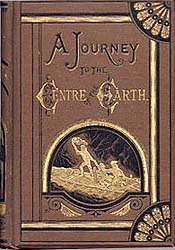 Realizing that I'd need a little more light and probably some additional gear and to be honest, a couple of other people to safely travel further into the cave, I decided to try and organize a mini expedition and was able to enlist the interest and participation of some of the volunteers from the Japan Overseas Cooperation Volunteers (JOCV) who I worked with in the Fisheries Division. The JOCV were similar to the U.S. Peace Corps except that the Japanese Government provided their volunteers with all sorts of wonderful things including tools and cars to help them in their jobs. So later that week over a few beers at the RSA club, I managed to convince my colleagues that crawling into a hole in the ground and exploring the unknown was a worthwhile way to spend a Saturday. I have to give them a lot of credit in that they jumped at the chance and in typical fashion, started to organize themselves into what I jokingly referred to as the Japanese Overseas Explorationary Force.
Realizing that I'd need a little more light and probably some additional gear and to be honest, a couple of other people to safely travel further into the cave, I decided to try and organize a mini expedition and was able to enlist the interest and participation of some of the volunteers from the Japan Overseas Cooperation Volunteers (JOCV) who I worked with in the Fisheries Division. The JOCV were similar to the U.S. Peace Corps except that the Japanese Government provided their volunteers with all sorts of wonderful things including tools and cars to help them in their jobs. So later that week over a few beers at the RSA club, I managed to convince my colleagues that crawling into a hole in the ground and exploring the unknown was a worthwhile way to spend a Saturday. I have to give them a lot of credit in that they jumped at the chance and in typical fashion, started to organize themselves into what I jokingly referred to as the Japanese Overseas Explorationary Force.
I believe that my fascination with things subterranean began the first time that I read Jules Verne's 1864 classic science fiction novel, Journey to the Center of the Earth. No matter how many times I have read the book, to this very day the hairs on the back of my neck still stand up everytime I read the translation of those runic characters written by that famous Icelandic explorer, Arne Saknussemm, which declared "Descend, bold traveler, into the crater of Snaefellsjokull, which the shadow of Scartaris touches before the calends of June, and you will attain the centre of the earth; I did it. Arne Saknussemm".
![]() This fascination might have been further reinforced by the fact that a cousin of mine who used to work in the publicity department of Twentieth Century Fox, knowing my love of this book, sent me a package of publicity stills from their newly released film version of this incredible book. I can still remember covering my wall with pictures from the movie and still have one of the original lobby cards that I cherish dearly. Combine this with my love of the sea and there is perhaps no more appropriate image of who I am than that of the characters of this adventure sailing across the vast central sea on their makeshift and somewhat beleaguered raft.
This fascination might have been further reinforced by the fact that a cousin of mine who used to work in the publicity department of Twentieth Century Fox, knowing my love of this book, sent me a package of publicity stills from their newly released film version of this incredible book. I can still remember covering my wall with pictures from the movie and still have one of the original lobby cards that I cherish dearly. Combine this with my love of the sea and there is perhaps no more appropriate image of who I am than that of the characters of this adventure sailing across the vast central sea on their makeshift and somewhat beleaguered raft.
On the day that I'd hoped would be our own Journey into the Center of the Earth, I rode my beaten up little motorcycle over to the house where the JOCV volunteers lived and was amazed to see enough gear to outfit an expedition to the ends of the earth piled in the middle of the living room and most astoundingly, to see them all wearing the coolest looking jumpsuits that I had ever seen. I must admit that for a moment I felt a little underdressed and unprepared in my jeans and ripped New York City tee shirt.
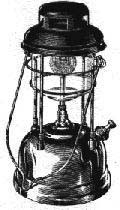
However, I did feel better once I realized that I did remember to bring along my wonderful Tilley pressure storm lantern that I used on my little sailboat and that had saved my life at least once and all they had were some flashlights. With all the gear that we were bringing, I was very thankful that we were going to use one of the JOCV-provided pickup trucks to get there and so we all piled in and those who couldn't fit inside climbed in the back and we headed off down the road.
![]() We soon left the barely paved and pothole-filled streets of Apia and headed off towards the road that soon turned into a dirt track that led towards the cave, about six miles or so outside of town. When we got to the end of the road, we met with the family whose land the cave was located on and since I had already been there once before, there was no problem explaining what we were trying to do. However, they did express some serious reservations about why any sane person might want to crawl into a hole in the ground where one is likely to encounter what the Samoans refer to as aitu, which can best be translated as ghosts or spirits. I must also add that they were also really impressed with the JOCV's jumpsuits. To make sure that we didn't get lost, they asked one of their sons to lead us to the cave entrance which was great since I now no longer felt like the most underdressed member of the expedition - at least I was wearing shoes.
We soon left the barely paved and pothole-filled streets of Apia and headed off towards the road that soon turned into a dirt track that led towards the cave, about six miles or so outside of town. When we got to the end of the road, we met with the family whose land the cave was located on and since I had already been there once before, there was no problem explaining what we were trying to do. However, they did express some serious reservations about why any sane person might want to crawl into a hole in the ground where one is likely to encounter what the Samoans refer to as aitu, which can best be translated as ghosts or spirits. I must also add that they were also really impressed with the JOCV's jumpsuits. To make sure that we didn't get lost, they asked one of their sons to lead us to the cave entrance which was great since I now no longer felt like the most underdressed member of the expedition - at least I was wearing shoes.
The eight of us grabbed our gear from the truck, headed off through the bush and much quicker than last time, found the entrance to the cave. In addition to the lamp, I also brought along a little pad of paper and a pen that I planned to use to make a map of the cave as we went along. I realized that to do it properly I'd need a compass and something that would allow me to measure how much the cave floor was going up or going down but I figured that I'd do the best I could with what I had and to be completely honest, I was drawing as we went so that in case we got to a point where we felt that we had lost our way, at least there would be something to hopefully, guide us back out into the light of day. I will illustrate this story with sections of that map to better place the text and photos in context. In retrospect, I realize that we were woefully unprepared in so many ways and frankly, am amazed that we were able to do what we did and live to talk about it. But I fear that I am getting ahead of myself because at this point, we were still sitting at the mouth of the cave.
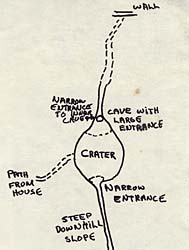 We decided to start off with the easier of the two entrances, the larger opening to the south. I walked in first and when I got near the bottom of the slope, turned around and took a picture of my companions, watching me with great interest. You can see the picture that I took at the top of this page. The entrance narrowed and now joined by the rest of the team, we headed off to see what we could find. Sadly, we didn't have to go very far before we found our answer - nothing! Apparently, at some time in the past there must have been a rockslide or something because after having only gone a few hundred feet back from the entrance, we were faced with a solid wall of rock. Feeling somewhat deflated, we turned around and made our way back out into the light and climbed back out of the rather steep entrance. Regrouping, we headed over to the other entrance that I had found during my last visit and after lighting my trusty lamp, crounched down and made my way into what I'd hoped would be a more rewarding and extensive exploration. I walked down a very steep slope and with the bright light of my Tilley lamp illuminating the path ahead, I could see that thankfully, the cave continued on for as far as I could see.
We decided to start off with the easier of the two entrances, the larger opening to the south. I walked in first and when I got near the bottom of the slope, turned around and took a picture of my companions, watching me with great interest. You can see the picture that I took at the top of this page. The entrance narrowed and now joined by the rest of the team, we headed off to see what we could find. Sadly, we didn't have to go very far before we found our answer - nothing! Apparently, at some time in the past there must have been a rockslide or something because after having only gone a few hundred feet back from the entrance, we were faced with a solid wall of rock. Feeling somewhat deflated, we turned around and made our way back out into the light and climbed back out of the rather steep entrance. Regrouping, we headed over to the other entrance that I had found during my last visit and after lighting my trusty lamp, crounched down and made my way into what I'd hoped would be a more rewarding and extensive exploration. I walked down a very steep slope and with the bright light of my Tilley lamp illuminating the path ahead, I could see that thankfully, the cave continued on for as far as I could see.
![]()
I climbed back out of the cave, told my companions what I had found and then one by one, they entered the narrow opening and waited just inside until we had all made it through. Leading the way I would periodically turn around and I could see the beams of one flashlight after another start to make their way down the slope.
When I set about to try and assemble my thoughts, pictures and maps to help tell the story of our visit to the caves at Falemauga, I wondered whether or not there might actually be some information about the caves that would be available now that I had not known about back in 1977. Thanks to the incredible power of the modern internet search engines, within seconds of typing in the words "Falemauga Cave" or "Falemaunga cave", I was able to crawl into a wealth of literature much as I had crawled into the guano-filled cave at Falemauga so many years before. The crown jewel in this search turned out to be an article written by J.D. Freeman in 1944 in The Journal of the Polynesian Society. Freeman's description of the cave answered many of the questions that had lingered in my mind after all these years. Freeman's report also provided a wealth of valuable information about the geological, archaeological and historical background of the cave and it amazed me that although it was written nearly thirty three years before my adventure, it would be almost thirty three years after I first set foot in the cave at Falemauga that I would discover it. Where appropriate, I will augment my recollections with some descriptions by Freeman.
![]()
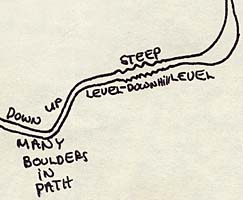 It is really hard to try and describe the feeling one has when first walking into a cave and with each step in your descent, see the world that you are familiar with gradually fade away until all that is left is a tiny pinpoint of light. As we made our way down the first steep downhill slope away from the entrance, I noticed more than once that everyone would stop and turn around every few steps to look back towards the ever diminishing opening into the world above, perhaps to reassure themselves that it was still there. However, we soon came to a section in the cave where the passageway made a sharp turn and what I can only describe as an opening more resembling the the throat of some giant creature than anything else that I was familiar with, lay in front of us. We all stopped for a moment, took one last look back at the barely visible dot of light that marked the world we knew and turned the corner and started to make our way down a very steep, low ceilinged passageway.
It is really hard to try and describe the feeling one has when first walking into a cave and with each step in your descent, see the world that you are familiar with gradually fade away until all that is left is a tiny pinpoint of light. As we made our way down the first steep downhill slope away from the entrance, I noticed more than once that everyone would stop and turn around every few steps to look back towards the ever diminishing opening into the world above, perhaps to reassure themselves that it was still there. However, we soon came to a section in the cave where the passageway made a sharp turn and what I can only describe as an opening more resembling the the throat of some giant creature than anything else that I was familiar with, lay in front of us. We all stopped for a moment, took one last look back at the barely visible dot of light that marked the world we knew and turned the corner and started to make our way down a very steep, low ceilinged passageway.
![]() At times our walking became very difficult because of many large boulders strewn all over the path and when we couldn't make our way around or between them, we were often forced to climb over them which in some places, especially where the roof came down quite low, proved quite a challenge. The path once more took a few sharp turns and at one point, seemed to split into two parts with a very large and very deep pit separating them. It was still early in our journey and since we'd hoped that there was still more ahead of us to explore, we did not try climb down into this pit and see whether or not there might have been another passageway leading off from the bottom but decided to continue onwards.
At times our walking became very difficult because of many large boulders strewn all over the path and when we couldn't make our way around or between them, we were often forced to climb over them which in some places, especially where the roof came down quite low, proved quite a challenge. The path once more took a few sharp turns and at one point, seemed to split into two parts with a very large and very deep pit separating them. It was still early in our journey and since we'd hoped that there was still more ahead of us to explore, we did not try climb down into this pit and see whether or not there might have been another passageway leading off from the bottom but decided to continue onwards.
One of the things that we had become aware of as we made our way through the cave was the appearance along each side of the passageway of what at first glace appeared to be large piles of rocks, approximately three feet high, perhaps we thought, being the result of countless small rockslides throughout the years. However, as we noticed more and more of them and saw that their shapes were rather distinct and that the rocks appeared to have been intentionally placed by humans rather than haphazardly dropped by nature, it became clear that these stone platforms were obviously not natural but most likely built by the Samoans in ancient times. Try as I might, I found it rather difficult to imagine why anyone would willingly choose to live deep inside a dark, damp, bat-infested cave when to be honest, life above ground in Samoa would certainly qualify as most people's definition of paradise. However, because of the sheer number of these platforms and the number of people that they meant would have used them, it was quite obvious that the cave was used at some point by a great many people.
![]()
![]() According to Freeman's report "the Falemauga caves were used as a place of refuge by the people of Tuamasanga (the district occupying the central portion of the island of Upolu...) during the invasion of Samoa by the Tongans. Much detail has naturally been forgotten, for the Tongan invasion took place over 700 years ago, but the caves were used as a place of hiding by the women and children and the old men, while a fort was built by the warriors some little distance away to offer resistance to the Tongans should they attempt an offensive."
According to Freeman's report "the Falemauga caves were used as a place of refuge by the people of Tuamasanga (the district occupying the central portion of the island of Upolu...) during the invasion of Samoa by the Tongans. Much detail has naturally been forgotten, for the Tongan invasion took place over 700 years ago, but the caves were used as a place of hiding by the women and children and the old men, while a fort was built by the warriors some little distance away to offer resistance to the Tongans should they attempt an offensive."
In order to be able to live in the caves, the Samoans built a large number of raised stone platforms, similar in many regards to the platforms upon which the traditional Samoan houses, or fale are built.
Freeman noted that "the platforms in the Falemaunga caves are all built up to a height of from two to three feet. This has been necessitated by the uneven nature of the floor of the tunnels. The platforms are constructed in the main from pieces of fallen lava-rock. In most cases only two retaining-walls have been built, for wherever possible advantage has been taken of the natural contours of the tunnels....The pieces of lava-rock composing the walls have been neatly and securely fitted together and upon excavation these walls proved to be over 2 feet in thickness. The surface of the platform consists of fine lava rubble, and closely resembles the floor of an ordinary Samoan fale. The surface of some of the other platforms, however, merely consists of a rough mosaic of large pieces of lava."
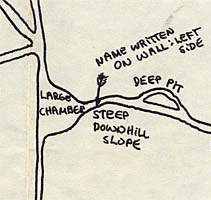
![]() Moving on carefully past the pit, the fairly level passageway soon became a very steep slope. As we carefully walked down, the ceiling and the walls seemed to fall away until we stood at the opening of what appeared to be a very large amphitheater-like chamber. I was instantly reminded of the scene from Journey to the Center of the Earth, in which the travellers emerge from their claustrophobic subterranean wanderings into the vast underground sea. Although fairly powerful, my Tilley lamp was unable to fully illuminate the entire chamber leaving vast sections pitch black outside of my lamp's reach. However, by shining the flashlights in all directions we could begin to grasp the enormous extent of this subterranean room. Freeman wrote that "...it is noticeable that most attention has been devoted to the platforms around about the amphitheatre... This area, spacious as it is, may be considered as corresponding to the malae of a village, and it is probable that the platforms there were reserved for chiefs and their families". Every traditional Samoan village has a malae, a large, open area, which serves as the ceremonial center of the village.
Moving on carefully past the pit, the fairly level passageway soon became a very steep slope. As we carefully walked down, the ceiling and the walls seemed to fall away until we stood at the opening of what appeared to be a very large amphitheater-like chamber. I was instantly reminded of the scene from Journey to the Center of the Earth, in which the travellers emerge from their claustrophobic subterranean wanderings into the vast underground sea. Although fairly powerful, my Tilley lamp was unable to fully illuminate the entire chamber leaving vast sections pitch black outside of my lamp's reach. However, by shining the flashlights in all directions we could begin to grasp the enormous extent of this subterranean room. Freeman wrote that "...it is noticeable that most attention has been devoted to the platforms around about the amphitheatre... This area, spacious as it is, may be considered as corresponding to the malae of a village, and it is probable that the platforms there were reserved for chiefs and their families". Every traditional Samoan village has a malae, a large, open area, which serves as the ceremonial center of the village.
![]() While a few of my companions took a brief rest in the center of the chamber, I climbed back up to the entrance through which we had initially entered and placing my camera on a rock and setting the self-timer, took a portrait of my friends and because of a slight miscalculation on my part, the back of my head.
Before leaving the amphitheater, I decided to try my self-timer one more time and see whether or not I could get a group shot of all of us and this time, I was a bit more successful.
While a few of my companions took a brief rest in the center of the chamber, I climbed back up to the entrance through which we had initially entered and placing my camera on a rock and setting the self-timer, took a portrait of my friends and because of a slight miscalculation on my part, the back of my head.
Before leaving the amphitheater, I decided to try my self-timer one more time and see whether or not I could get a group shot of all of us and this time, I was a bit more successful.
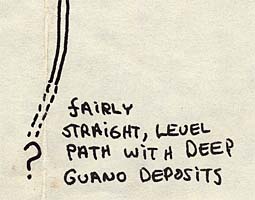 In addition to the opening that we had entered through high above the amphitheater, there were two other passages leading off in opposite directions that we wanted to explore. Without anything to lead us in one direction or the other we chose the path out of the left side of the chamber which seemed to be the most straight and level. However, before too long we noticed that the hard lava rock floor that much of the cave was made of started giving way to an ever deepening layer of bat guano. As we went further along, the deposits got deeper and deeper and our progress slowed and the level of comfort diminished until we finally reached a point where it was almost impossible to walk.
In addition to the opening that we had entered through high above the amphitheater, there were two other passages leading off in opposite directions that we wanted to explore. Without anything to lead us in one direction or the other we chose the path out of the left side of the chamber which seemed to be the most straight and level. However, before too long we noticed that the hard lava rock floor that much of the cave was made of started giving way to an ever deepening layer of bat guano. As we went further along, the deposits got deeper and deeper and our progress slowed and the level of comfort diminished until we finally reached a point where it was almost impossible to walk.
![]() Although we could see that the passageway seemed to continue on in a fairly straight, unobstructed manner as far as our lights could reveal, we decided that wading through an ever deepening primordial ooze was not the best plan of action so we turned back and I made a note on my map that this passage remained unexplored.
Although we could see that the passageway seemed to continue on in a fairly straight, unobstructed manner as far as our lights could reveal, we decided that wading through an ever deepening primordial ooze was not the best plan of action so we turned back and I made a note on my map that this passage remained unexplored.
Making our way back through the amphitheater, we took the passage leading out the other side and were immediately faced with three choices. Deciding to proceed straight ahead, we made our way along a fairly gradual downhill slope passing an opening on our left as we went along until once again, came face to face with a solid wall of rock blocking any further forward progress. Using the map as our guide we backtracked until we came to the opening that we had seen before and followed it.
We came upon a rather large stone platform which looked as if it had either been abandoned before the construction finished or that it had been systematically excavated, because there were piles of rock scattered about around the perimeter of the platform.
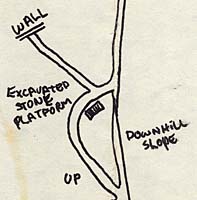 In reading Freeman's paper thirty years later and looking carefully at his map of the cave, while difficult to be certain, it does appear that this may have indeed been one of the platforms that Freeman excavated and described in detail in his paper. Freeman wrote that "Eight of the platforms and several mounds of lava-rubble each in a separate area of the north cave were accordingly excavated. Most of these excavations proceeded to a depth of above four feet before the floor of the tunnel was reached. In all cases it was found that the platforms were constructed of pieces of lava, in some cases quite massive, overlaid with lava rubble. These excavations did serve to demonstrate the immense amount of work which must have gone into the construction of the platforms. When all the circumstances are taken into consideration one cannot fail to be impressed by the fact that such a great number of laboriously-constructed platforms should be found at such a distance underground, for some of them lie over one-quarter of a mile from the entrance to the tunnel".
In reading Freeman's paper thirty years later and looking carefully at his map of the cave, while difficult to be certain, it does appear that this may have indeed been one of the platforms that Freeman excavated and described in detail in his paper. Freeman wrote that "Eight of the platforms and several mounds of lava-rubble each in a separate area of the north cave were accordingly excavated. Most of these excavations proceeded to a depth of above four feet before the floor of the tunnel was reached. In all cases it was found that the platforms were constructed of pieces of lava, in some cases quite massive, overlaid with lava rubble. These excavations did serve to demonstrate the immense amount of work which must have gone into the construction of the platforms. When all the circumstances are taken into consideration one cannot fail to be impressed by the fact that such a great number of laboriously-constructed platforms should be found at such a distance underground, for some of them lie over one-quarter of a mile from the entrance to the tunnel".
While my companions were taking a closer look at the platform, I noticed that there was another passage behind me which I decided to explore. Unfortunately, I didn't have to go very far before I found that it too, was a dead end. Rejoining my companions, we continued on and after not too long were amazed to find ourselves back to the original three part junction that we had only recently left and which we recognized only because it was adjacent to the amphitheater. With two out of the three possible routes out of this side of the amphitheater leading nowhere, we crossed our fingers and headed off into the third passageway which soon started to head in an upwards direction. The numerous dead ends, going around incircles and the retracing of steps reminded me of a similar situation faced by Verne's subterranean explorers.
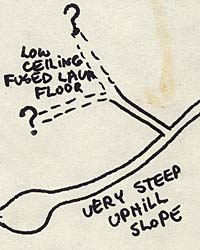 Thankfully, this passageway continued unobstructed and after a short while we saw that there was a side branch off to the right that looked promising. Walking in a little way we noticed that the floor of the cave looked very different from the rest of the cave that we had seen. It was less covered with the guano-laced mud that we had grown accustomed to and it reflected our lights in an almost mirror-like way. Before long, the passageway split into two and after a little careful exploration, we were faced with an ever lowering ceiling and a glasslike fused lava floor coming closer and closer towards each other. Being uncertain as to how far these passageways went and frankly, getting a little tired and not wanting to assume the snakelike position required to continue on, we decided to turn around and go back to the main passage and mark these two sections with a question mark - best left for future exploration.
Thankfully, this passageway continued unobstructed and after a short while we saw that there was a side branch off to the right that looked promising. Walking in a little way we noticed that the floor of the cave looked very different from the rest of the cave that we had seen. It was less covered with the guano-laced mud that we had grown accustomed to and it reflected our lights in an almost mirror-like way. Before long, the passageway split into two and after a little careful exploration, we were faced with an ever lowering ceiling and a glasslike fused lava floor coming closer and closer towards each other. Being uncertain as to how far these passageways went and frankly, getting a little tired and not wanting to assume the snakelike position required to continue on, we decided to turn around and go back to the main passage and mark these two sections with a question mark - best left for future exploration.
Walking became much more difficult because the slope of the passage became very steep in an upwards direction which prompted a number of short rest stops along the way until we entered another very large chamber. This chamber while smaller than the amphitheater, was still much more expansive than the typical passageway that we had become used to. After a short survey of this chamber, we moved on and found ourselves now on a very steep downward slope which allowed us to make relatively quick progress. We passed another deep hole which was left unexplored and then came upon a section of the cave that was unlike any others that we had seen.
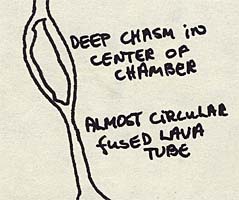 Stopping almost in unison, we stared in amazement as ahead of us was a fairly level, an almost circular lava tube with a glass-like floor. It was the first part of the cave where we could clearly get a sense of the intense heat of the molten lava that had once coursed through the very spot where we stood.
Stopping almost in unison, we stared in amazement as ahead of us was a fairly level, an almost circular lava tube with a glass-like floor. It was the first part of the cave where we could clearly get a sense of the intense heat of the molten lava that had once coursed through the very spot where we stood.
I would imagine that with adequate lighting, this lava tube would be quite spectacular. The beams from our flashlights bounced off the floor and the light from my Tilley lamp was reflected upwards off the glass-like floor and bathed the lower walls in the soft glow of pressurized kerosene.
![]() One by one, we walked slowly through this truly magical place with each person putting out their hands and gently running their fingers along the wall.
One by one, we walked slowly through this truly magical place with each person putting out their hands and gently running their fingers along the wall.
The tube finally came to an end and the path split, divided by a very large and deep chasm. One of our team, a fellow who was smart enough to bring along his motorcycle helmet, decided that he wanted to take a look at the chasm and carefully made his way down the boulder-strewn slope. He didn't get very far before realizing that the chasm did not lead to any place that was easily accessible and wisely, climbed carefully back out of the hole.
The two paths came back together on the far side of the chasm and not too far ahead, was another narrow branch off to the right heading off in a downward direction. It started to feel as if things were beginning to close in around us when the branch that we had just attempted to explore proved to have been blocked by a rock fall and the way up ahead looking smaller and smaller.
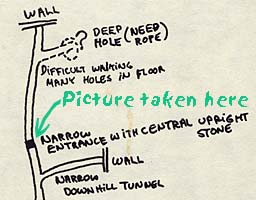 We finally reached a place where the roof of the cave just about met the ground and where a large rock thrust vertically out of the ground like a finger either pointing the way or expressing its displeasure at us being there. It seriously looked as if we had come to the end of the road but in looking past the rock, I noticed a very narrow and very low passage that seemed to continue further on.
We finally reached a place where the roof of the cave just about met the ground and where a large rock thrust vertically out of the ground like a finger either pointing the way or expressing its displeasure at us being there. It seriously looked as if we had come to the end of the road but in looking past the rock, I noticed a very narrow and very low passage that seemed to continue further on.
![]()
I think that most of the folks were prepared at this point to call it a day. However, before I was willing to give up, I wanted to at least see whether or not there was even a chance of getting further into the cave so I volunteered to take a look. Just before I got on my stomach and inserted myself into the mud and guano covered tunnel, one of my companions snapped a photo and I honestly had to wonder if they thought this would be the last that they'd ever see of me.
I honestly can't remember how far I crawled through that tunnel with just a single flashlight held in my hand but eventually, the roof started to open up and I found myself in yet another walkable passageway. This part of the cave seemed quite different from the other sections in that the floor was filled with many holes making walking quite difficult and potentially dangerous, especially by the light of a small and ever-dimming flashlight. Since it looked like there might be more of the cave still ahead of us to explore, I dove back into the tunnel and made my way back to my companions to explain what I had found and to decide what to do next.
The more enthusiastic (or foolhardy)of us decided that we would continue on and that the rest would remain at the entrance to the tunnel - just in case. Knowing what lay on the other side, this time I decided to take my Tilley lamp with me and leading the way, gently pushed it ahead of me as we crawled back through. The additional light that it provided certainly helped make the walk through the crater strewn passageway on the other side a little easier and a great deal safer. We walked on for a while and came to a section of the cave where it brached off yet again. Continuing straight along on what we believed to be the main passage, we were very disappointed to find that our way was blocked by yet another rock fall with no obvious way around, over or under. Backtracking, we retraced our steps until we came to the branch that we had passed and headed in. Once again I can honestly say that my wonderful little Tilley lamp saved my life. Walking slowly along the passageway with a small but reassuring circle of light from my trusty lamp illuminating the ground in front of me, the bottom of the cave just disappeared. Before us was a sheer drop, so deep that our lamps could not reveal the bottom and with no way around, we had come to the end of our rope - that is assuming that we had actually brought any ropes with us. If we had, I am sure that we would have at least tried to see where this chasm may have led but without a sure way of getting back out, we all agreed that this was as far as we could safely go.
![]() Retracing one's steps is never quite as exciting as heading off into the unknown. I have to admit, however, that it was very reassuring to have that map, which you can be certain was held tightly in my hand, to help us find our way back through the myriad of passages and dead ends that we had explored that day and hopefully, back into the light of day. I've never quite understood why the return journey never seems to take as long as the outward bound one so after what seemed like a remarkably short time, we could make out the very faint glimmer of light up ahead that with each successive step, grew larger and brighter. I had mixed feelings about that last long uphill climb into the light since I knew that we had left many sections of the cave unexplored and had probably missed many interesting features of the sections that we passed through because of our lack of adequate lighting and equipment. However, the things that we did see were wonderous indeed and I felt very gratified in that with the help of my friends, was able to realize my own somewhat abbreviated journey to the center of the earth.
Retracing one's steps is never quite as exciting as heading off into the unknown. I have to admit, however, that it was very reassuring to have that map, which you can be certain was held tightly in my hand, to help us find our way back through the myriad of passages and dead ends that we had explored that day and hopefully, back into the light of day. I've never quite understood why the return journey never seems to take as long as the outward bound one so after what seemed like a remarkably short time, we could make out the very faint glimmer of light up ahead that with each successive step, grew larger and brighter. I had mixed feelings about that last long uphill climb into the light since I knew that we had left many sections of the cave unexplored and had probably missed many interesting features of the sections that we passed through because of our lack of adequate lighting and equipment. However, the things that we did see were wonderous indeed and I felt very gratified in that with the help of my friends, was able to realize my own somewhat abbreviated journey to the center of the earth.
And like the wayward compass that Verne's adventurers tucked away in a cabinet after their return home only to be found again long after and was to reveal the true story behind their journey, so too has that long lost map of mine reawakend memories that have lain dormant for way too many years. And to quote from the last chapter of Verne's novel, spoken by Professor Liedenbrock's nephew, "Such is the conclusion of a history which I cannot expect everybody to believe, for some people will believe nothing against the testimony of their own experience. However, I am indifferent to their incredulity, and they may believe as much or as little as they please."
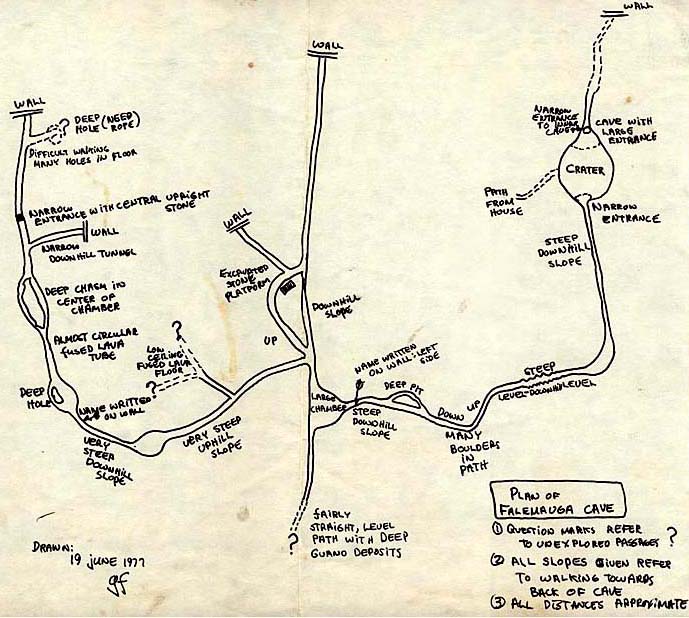
Here are links to just some of the information that is now available about the cave at Falemauga:

gene carl feldman (gene.c.feldman@nasa.gov) (301) 286-9428